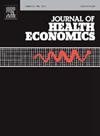The impact of neonatal care on moderate-risk infants: Evidence from healthcare use in the first two years of life
IF 3.6
2区 经济学
Q1 ECONOMICS
引用次数: 0
Abstract
Advances in evidence-based neonatal care have led to large improvements in the survival rates of high-risk newborns. Yet studies have documented wide variation in the care of more prevalent moderate-risk infants, who comprise a much larger proportion of admissions to neonatal care. In this study, we build on a small literature which uses quasi-experimental design to understand the impact of neonatal care, and for the first time, examine this moderate-risk cohort of infants. We use individual-level data on the full population of births in the state of New South Wales, Australia to examine the impact of neonatal care on the healthcare use of moderate-risk infants in the first two years of life. We implement a regression discontinuity design exploiting admission protocols based on birthweight among neonatal units of three different and explicit levels of capability. Unlike previous studies, which examine differences in outcomes across the high-risk cut-off at 1500 g, our study examines differences for moderate-risk infants born near birthweight cut-offs closer to normal birth weight (2500 g). While admission to the neonatal unit jumps across the cut-off, we find modest impacts on downstream healthcare use, including both in-hospital and out-of-hospital care. However, we identify heterogeneous effects across varying capability levels. Moderate risk infants admitted to lower capability neonatal units received more cost-intensive care, resulting in reduced healthcare use following discharge from hospital, while the same was not observed for those admitted to the highest capability units. We suggest that this is due to more aggressive clinical management at lower capability units, and leave this as a priority for future research.
新生儿护理对中等风险婴儿的影响:来自生命头两年医疗保健使用的证据
循证新生儿护理的进步导致高危新生儿存活率的大幅提高。然而,研究表明,对更普遍的中等风险婴儿的护理存在很大差异,这些婴儿在新生儿护理中所占的比例要大得多。在这项研究中,我们建立在一个小文献,使用准实验设计来了解新生儿护理的影响,并首次检查这个中等风险的婴儿队列。我们使用澳大利亚新南威尔士州全部出生人口的个人数据来检查新生儿护理对生命头两年中度风险婴儿医疗保健使用的影响。我们实施了一个回归不连续设计,利用基于出生体重的入院协议,在三个不同的和明确的能力水平的新生儿单位。与以往的研究不同的是,我们的研究考察了在1500克的高危分界点附近出生的中等风险婴儿的差异,这些婴儿的出生体重分界点更接近正常出生体重(2500克)。虽然新生儿病房的入院率跨越了临界值,但我们发现对下游医疗保健使用的影响不大,包括院内和院外护理。然而,我们在不同的能力水平上识别异质效应。在能力较低的新生儿病房住院的中度风险婴儿接受了更多的成本密集型护理,导致出院后医疗保健使用减少,而在能力最高的病房住院的婴儿则没有观察到这种情况。我们认为这是由于较低能力单位的更积极的临床管理,并将其作为未来研究的优先事项。
本文章由计算机程序翻译,如有差异,请以英文原文为准。
求助全文
约1分钟内获得全文
求助全文
来源期刊

Journal of Health Economics
医学-卫生保健
CiteScore
6.10
自引率
2.90%
发文量
96
审稿时长
49 days
期刊介绍:
This journal seeks articles related to the economics of health and medical care. Its scope will include the following topics:
Production and supply of health services;
Demand and utilization of health services;
Financing of health services;
Determinants of health, including investments in health and risky health behaviors;
Economic consequences of ill-health;
Behavioral models of demanders, suppliers and other health care agencies;
Evaluation of policy interventions that yield economic insights;
Efficiency and distributional aspects of health policy;
and such other topics as the Editors may deem appropriate.
 求助内容:
求助内容: 应助结果提醒方式:
应助结果提醒方式:


